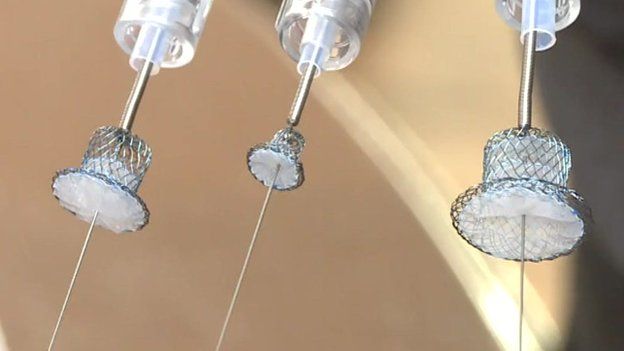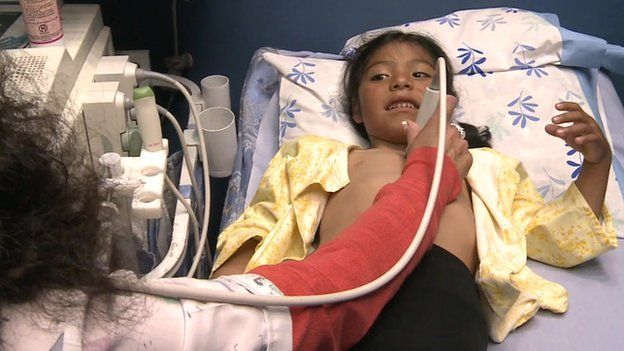
Traditional craft skills are helping to save the lives of children born with heart defects in Bolivia.
The indigenous Aymara women have centuries of experience of knitting and weaving distinctive woollen hats, sweaters and blankets.
Now, they are applying their expertise to a hi-tech medical product – which is used to seal up a “hole in the heart” which some babies are born with.
“We are very happy, we are doing something for someone so they can live,” says knitter Daniela Mendoza, who weaves the tiny device in a special “clean room”.
It takes her about two hours to make the Nit Occlud device which was designed by cardiologist Franz Freudenthal. He set up his clinic in La Paz to help children born with heart problems and so far he has saved hundreds of lives.
The device, known as an occluder, looks similar to a top hat and is used to block the hole in the patient’s heart.
Most standard occluders are made on an industrial scale – but Freduenthal’s version is so small and intricate that it’s technically tricky to mass produce.
So he enlisted an army of Bolivia’s traditional craft knitters to make them by hand.
In the early days he tested the first prototypes on sheep with heart problems. He’s since successfully used them on hundreds of children and now exports his new inventions all over the world.
“The most important thing is that we try to get really really simple solutions for complex problems,” Dr Freudenthal told the BBC.
A device with memory

Bolivia is the poorest country in south America and lacks enough specialist hospitals and cardiac doctors to treat children born with heart problems. So cheap innovations are welcome.
Freudenthal’s devices are made by weaving a single strand of a super-elastic metal used in military industries.
Known as nitinol, a nickel-titanium alloy, it can memorise its own shape and can be folded up inside a slim catheter which a cardiologist inserts into the the groin. The device remains folded as it travels through blood vessels – and is only expanded when it reaches the right place in the heart.
Recovering its original shape, it then blocks the hole or ductus that causes the heart problems. It can stay there without the need to be changed.
Dr Freudenthal has earned international praise and awards for his combination of traditional craft techniques and high technology to fix hearts.
This minimally invasive approach also helps to avoid cultural barriers to treatment: manipulating a heart is considered an act of desecration on the human soul by some indigenous communities in Bolivia.
“By not operating with an open heart” says Dr Freudenthal, “We are also respecting the will of many patients who would not want their children to be operated otherwise.”
The problem of altitude

People who live with congenital heart problems struggle to gain weight and are easily fatigued, as their hearts have to work three times harder than a healthy one to pump blood around the body.
The problem the device aims to fix is a hole in the heart – which is also known as a patent ductus arteriosus or PDA.
Before birth a baby gets oxygen from its mother. A blood vessel which is called the ductus arteroiosus allows blood to bypass the lungs closes up on its own soon after birth.
But if it fails to close naturally then there is irregular blood flow in the heart. This can lead to symptoms of breathlessness and a failure to thrive – although there are often no symptoms if the problem is mild.
Due to the high altitude and lack of oxygen in La Paz – 4,000 metres above sea level – Freudenthal says that these kind of problems are 10 times more frequent here than in other countries.
‘She couldn’t walk one block’

Six-year-old Cinthia was operated on three years ago.
The blood that was supposed to supply her whole body with oxygen and nutrients used to escape through the ductus before it was stopped by one of Freudenthal’s devices.
Her mother Victoria Hilari recalls “She couldn’t even walk one block. She used to tell me she was too tired. She used to get purple when crying, she almost fainted.”
“That’s how I realised she had a problem, but I didn’t know what to do.
“Now she can run and she’s even passing physical education at school.”
Bolivia has one of the highest children mortality rates in the world.
At least for the patients at Dr Freudenthal’s clinic, the answer to their problem is in the hands of a group of skilled women with the power of fixing hearts – weaving to save lives.
Culled from :┬Āhttp://www.bbc.co.uk/news/health-32076070?

